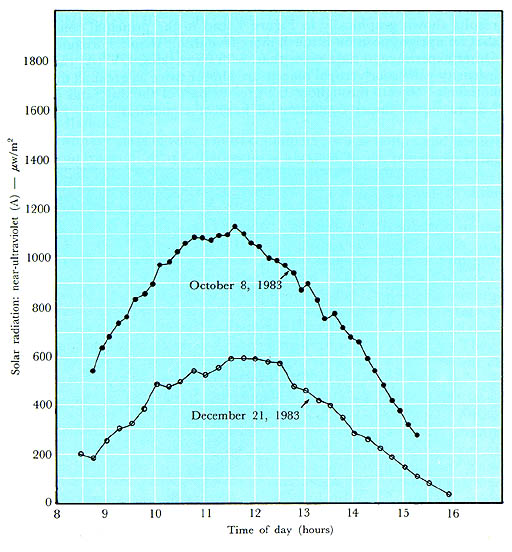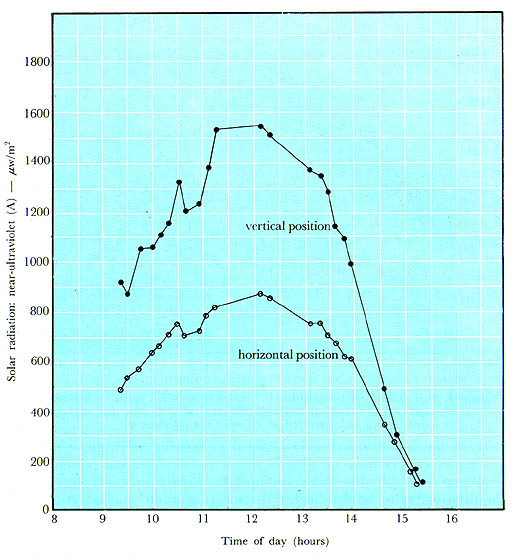Solar EnergySome Practical HintsPublished DataThe only available data issued by most of the meteorological stations is the total solar radiation (direct and diffuse radiations) received on the surface of an object placed horizontally. Very few stations provide data for the total radiation striking objects placed in a vertical position.For most solar radiation applications the available data may be sufficiently adequate, but is not quite so for purposes of solar disinfection of drinking water or oral rehydration solutions using bottles or other similar containers. This is on account of two important factors: (a) the effective component of solar radiation involved in microbial destruction is in the near-ultraviolet (A) band (300-400 nm), and to a lesser extent in the visible band of violet and blue lights (400-490 nm); and (b) from a practical standpoint, bottles or similar vessels used in the disinfection process must necessarily be kept upright during exposure to sunlight. In this context, therefore, some care must be taken in the interpretation of certain published data that may not be pertinent to specific local situations or applications. Ideally, each of the developing countries interested in the development of programmes for the exploitation of solar radiation should endeavour to establish solar research centres and monitoring stations. This has been the trend in recent years in some of the Arab states and other developing countries.
Seasonal VariationsIt is logical to question the feasibility of utilizing solar energy for any particular application in an effective manner throughout the year without serious setbacks or interruptions caused by seasonal variations in solar radiation. There is no doubt that seasonal variations could provoke marked changes in the effectiveness or productivity of solar dependent processes. For this reason it would be useful to consider the possible variations and their potential impacts.Seasonal variations are primarily due to changes in the solar altitude, and in cloud formation during the rainy season. These two factors determine not only the total amount of solar radiation reaching ground-level at a given location, but also the proportion of the various kinds of radiation. As a general rule, the lower the sun is with reference to the horizon the weaker is the total solar radiation, and the greater is the fraction of scattered light, mainly in the UV (A) and blue light bands. The reverse is also true when the solar altitude increases. Cloud formation may hinder the overall atmospheric transmission of solar radiation to a degree determined by the thickness and density of clouds. Very dense clouds, about 1000 m in thickness, are said to reflect back into space more than 90% of the incident solar radiation. Such occurrences, however, are generally of short duration in many parts of the world, and so their impact would be transient. In any event, scattered radiation continues to retain its destructive power against microorganisms, although it may be somewhat attenuated. In the northern hemisphere, for instance, nature decrees that during the winter months the total solar radiation is much reduced, and the length of the day becomes shorter. The lowest values occur in December and January. From then on the values increase gradually, reaching the highest levels in June and July. These facts are illustrated, at least in part, in Figure 3 which is based on hourly measurements of solar radiation at a wavelength peak of 357 n-m (an optimal radiation wavelength for microbial destruction). The UV radiation measurements were made in Beirut, Lebanon, on two cloudless days (October 8, 1983, and December 21, 1983), using a Spectroline DM-357X digital radiometer (obtained from Insect-O-Cutor Limited, Stockport, Cheshire, England). The important inferences drawn from the two graphs in Figure 3 indicate that solar radiation at a wavelength of about 357 nm decreases from October to December, and that the ultraviolet (A) radiation reaches its maximum level at about noontime regardless of the time of the year. In effect, this means that the microbial disinfection process is expected to be much more efficient in summer and autumn than in winter under clear sky conditions in Beirut. In practice, therefore, lengthening the sunlight exposure period for disinfection purposes during the winter months would accomplish the desired results.
Orientation of ReceiverIn solar operations using devices designed to collect or concentrate solar radiation, it is generally advised to keep the radiation receiver in a tilted position rather than in a horizontal position in order to be at right angles to the sun's rays. The recommended angle of inclination from the horizontal is equal to the latitude of the location, and the receiver is to face the south. The amount of sunlight collected and utilized is thus substantially increased, for as much as 50% of solar energy could be gained, particularly in winter when the sun is closer to the horizon.The question that presents itself regarding the solar disinfection process is whether a similar arrangement would be necessary and justifiable. To arrive at a conclusion in this regard, it would be necessary to evaluate the pertinent facts. For the usual solar processes the aim is to collect on the receivers as much direct sunlight as possible to attain an optimum efficiency. While this is partly true for solar decontamination operations, it should be noted that in these cases scattered radiation striking from all directions an upright receiving object (e.g. bottle holding water to be disinfected) presents an additional advantage. By tilting such an object, which is a practical problem, more direct sunlight is gained at the expense of scattered radiation.
To help resolve this issue, comparative measurements were made of the UV (A) radiation received on an object kept upright and then lying horizontally. Readings were taken at intervals throughout the day under clear sky conditions using the same radiometer described earlier. The results shown graphically in Figure 4 lead to the principal conclusion that an upright position is much more favourable than a horizontal one. Other experimental data show that, with clear skies, UV (A) radiation intensity values for vertical objects are almost twice as great as those for horizontal objects throughout the greater part of the day, and tend to become equal under conditions of haze or cloudiness.
Transmission Through GlassIn selecting containers for solar disinfection of water or oral rehydration solutions, the property of being transparent to sunlight is of utmost importance. Because of their widespread availability, glass containers should be considered with respect to transmission of solar radiation at different wavelength bands, particularly with respect to UV (A) radiation.Ordinary glass of which most containers such as bottles and jars are made can transmit solar radiation up to about 90%, the remainder being reflected or absorbed by the glass. The amount and kind of radiation that passes through ordinary glass depends on the colour and thickness of the glass, and on the specific wavelength bands of radiation. Colourless glass transmits solar radiation at wavelengths in the range of 320 to 700 nm. It is therefore opaque to radiation below 320 nm, and to infrared radiation. The maximum amount of radiation transmitted occurs at 400 nm. Pyrex glass, of which most laboratory glassware is made, is opaque to radiation below 280 nm, and attains a maximum transmission at 340 nm. Transparent plastic materials such as polystyrene and methylacrylate (Lucite and Plexiglass) can have a higher radiation transmittance than glass at wavelengths greater than 290 nm. These materials are therefore better than glass for the transmission of germicidal solar radiation at wavelengths from 300 to 400 nm. As for coloured glass, the commonest colouring agents are iron, manganese, chromium, copper, and cobalt; but iron is the main colouring material which gives glass a greenish tinge. Each of these colourants imparts to glass a characteristic tint, and causes the absorption of radiation at specific wavelengths. The iron content in ordinary glass determines the transmission of solar radiation at different wavelengths. Glass with a low iron content allows high radiation transmittance at all wavelengths of the spectrum. For wavelengths in the near-ultraviolet region (A) the transmittance is up to about 90%. As the iron content increases and the glass attains a darker green colour, the transmittance in the near-ultraviolet region (A) decreases, hut remains at a fairly high level in the visible region (400 to 700 nm). With coloured glass, the tint perceived by the sight is due to the specific wavelength of visible light transmitted through the glass. For instance, blue glass appears to have a blue tint because visible light in the blue band is transmitted much more than others. Similarly, red glass transmits mostly visible light in the red band of the spectrum. This is of importance in selecting the most appropriate coloured glass containers for solar disinfection purposes. Naturally, colourless glass with a low iron content would be the best choice. Next comes the blue tinted glass.
Transmission Through WaterThe discussion thus far has traced the fate of solar radiation as it treverses the atmosphere to strike a target at ground-level, which is assumed to be a glass or plastic container holding water or oral rehydration solution. It should be clear by now that the most effective germicidal component of solar radiation (300 to 400 nm) reaching the target container and penetrating its walls remains largely intact in terms of quantity, quality, and microbial destructive action. What remains to be considered is the transmission of the effective component of solar radiation through the water or aqueous solutions to reach the ultimate target -- the microogranisms to be destroyed.That sunlight can penetrate water is a well known phenomenon. In fact, it is an essential requirement to sustain the life of aquatic plants like algae that grow in water. An assessment of solar radiation transmission through colourless aqueous medium such as clear natural water points out the fact that, as the penetration path gradually increases, the radiation intensity decreases accordingly. The loss in intensity varies with wavelength, being particularly low for radiations of short wavelengths. For wavelengths ranging from 300 to 500 nm the reduction in intensity does not exceed 5% per metre of water depth. For the higher wavelengths the value me be as high as 40% per metre. The reduction at all wavelengths is largely due to radiation scattering, for absorption by clear natural water constitutes only a relatively small fraction. These facts show that UV (A) radiation will penetrate clear water to a depth of several metres before it is appreciably diminished in intensity. Obviously, then, UV (A) radiation can be readily transmitted through small volumes of clear water contained in transparent vessels. However, the picture differs in the case of coloured or turbid water. Substances imparting colour to water are likely to absorb radiation at specific wavelengths that vary with the nature of the substance. Since coloured waters are limited to highly polluted waters not fit for drinking, such cases are of no relevance here. On the other hand, suspended particles in water would cause radiation scattering by deflection from their surfaces in all directions. this phenomenon is known as the Tyndall effect. This can be easily demonstrated by viewing a bottle with turbid water against a source of light. The particles become visible, but not in the case of clear water or a clear solution of salt, for instance. In view of this information, water with a high content of suspended particles tends to obstruct the passage of a beam of solar radiation, the penetration depth depending upon the degree of turbidity of the water. In practice, this phenomenon could be neglected if the water is only slightly turbid; otherwise the turbidity needs to be reduced by allowing the larger particles to settle or, better still, by filtration or coagulation of the water.
|

